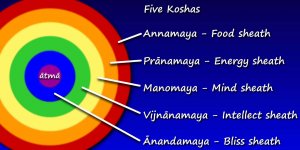| TV Channels / Documentaries |
The Inner Journey: A Course in Meditation
Part 4: Basic Steps of Preparation
A video presentation by Swami Tadatmananda Saraswati, Arsha Bodha Center, United States
(Tapescript) In the previous lesson, we discussed the first two of the eight limbs or angas of yoga taught by Pantanjali in his Yoga Sutras.
Now we can move on to the third anga, asana or posture.
The word asana often brings to mind the complex poses used in hatha yoga.
Hatha yoga is the practice that's taught in most yoga studios today, though it goes by many other names to distinguish certain variations.
Hatha literally means force, and it indicates a variety of physical practices, including these poses.
But what do these really have to do with meditation?
Ironically, if you meditate in the lotus pose, padmasana, like this, unless you're an advanced practitioner, you'll probably get distracted by sharp pain in your knees and legs.
To correctly understand the role of asana in meditation, we have to turn once again to Patanjali's sutras.
He defines asana very briefly in a single sutra, sthira-sukham asanam, your posture must be firm and comfortable.
Here, Patanjali simply indicates the proper seated position for the practice of meditation. He says nothing at all about the complicated poses practiced in today's yoga studios.
Hatha yoga's elaborate system of poses actually evolved after Patanjali's lifetime, and over a span of many centuries.
The purpose of that system is to prepare your body for extended periods of seated meditation.
Advanced meditators have to be able to sit still for hours, without being distracted by pain or needing to shift the position of their limbs.
Even in a comfortable chair, you'd probably find it difficult to sit perfectly still for several hours.
But, if you had practiced hatha yoga extensively, you wouldn't find it difficult at all.
Even though this system of poses was originally intended to prepare you for long hours of seated meditation, this fact is often overlooked.
In many yoga studios, poses alone are practiced, without any meditation whatsoever.
Because those poses focus on just one of yoga's eight angas, students in those studios are missing out on the other seven.
As odd as it might seem, practicing all those poses without meditating is like cooking a meal without eating it.
Now, unless you plan to meditate for hours at a time, you probably don't need to practice all those poses.
Yet it's absolutely necessary to sit in a correct position for meditation, with a posture that's firm and comfortable, as Patanjali says.
If you sit on the floor, it's usually good to have cushion beneath you and support for your back. It's also helpful to sit with your buttocks raised a few inches higher than your legs.
Or if you prefer, it's perfectly fine to sit in a chair. If you do, be sure to keep your back straight. Slumping forward can cause back pain and leaning backwards can make you drowsy.
More detailed instructions can be found in sixth chapter of the Bhagavad Gita, where Lord Krishna tells Arjuna how to sit for meditation.
He says, samam kaya-shiro-grivam, your body, neck, and head should be held erect.
That means, your head shouldn't droop downwards, nor should you hold your chin up unnaturally.
dharayan acalam sthirah, you should remain still, motionless.
When you get an itch or some other discomfort, you should try to ignore it. Most of the time, it'll go away after a while.
But, if it persists, then you should take care of it, to prevent it from becoming a continual source of distraction.
samprekshya nasikagram svam, your eyes should be directed downwards, towards the tip of your nose.
Your eyelids should be closed very gently to avoid creating any tension in the muscles around your eyes.
It's OK if a little bit of light peeks in through your eyelashes.
And finally, dishash ca anavalokayan, you shouldn't look anywhere else.
Obviously, if you hear a stray sound, don't look around to see where it came from.
Your hands should rest comfortably in your lap or on your knees.
There's no single correct position for your hands, although some Buddhist traditions specify that your right hand should cradle the left with the tips of your thumbs touching each other like this.
You might find it helpful to experiment with different positions of your hands.
Find out what feels most comfortable, then choose one position and use it each time you meditate.
Also, it's extremely important to choose a suitable location to meditate in. Places can strongly affect the way we feel.
For example, consider how different you feel when you're at work, or when you're at home, or when you visit a sacred place like a temple or chapel.
Your choice of location can either enhance your practice or impair it.
If you sit on your bed to meditate, you'll probably feel sleepy after a while.
If you sit on a chair in front of a television, you might get distracted more easily.
And if you sit in front of a computer to meditate, well, you get the idea.
It's best to set aside a place in your home and dedicate it exclusively for meditation, prayer, and spiritual study.
If you've already set up an altar of some kind, that place would be ideal.
Otherwise, you can create a special space in a quiet corner somewhere. You can furnish it with a cushion or chair, and if you like, you can decorate it with sacred objects that are meaningful to you.
Finally, it's helpful if you meditate in the very same place every time you practice. By doing this, you can gradually develop a strong mental association with that place. After a while, your mind will automatically quiet down as soon as you sit there.
Over a period of months and years, it will become a personal refuge, a sacred space that you return to eagerly, again and again.
Many activities require some preparation.
Each night before going to bed, you brush your teeth, you adjust your bedding, and you turn off the light.
This routine helps prepare you to get a good night s sleep.
In the same way, there's a series of three steps that can help prepare you for meditation.
You can use these steps as a standard routine at the beginning of each session.
The steps are asana, the proper seated posture that we've already discussed, followed by sankalpa or affirmation, and physical relaxation.
To understand the role of sankalpa, consider this.
Throughout the day, whether you're at work or at home, you're usually busy dealing with issues, solving problems, and coping with challenges.
Then, when you get a chance to close your eyes for meditation, all those activities often continue to occupy your mind.
And when you try to ignore them, your mind gets drawn back to those things.
The fact is, you have appointments to keep, groceries to buy, and phone calls to return. These things are important and they certainly deserve your attention. It would be irresponsible to simply ignore them.
So it's only natural for your mind to be drawn to all this.
Yet, as we discussed in the very first lesson, to temporarily withdraw from your responsibilities while meditating can prepare you to deal with them more effectively.
Meditation can rejuvenate and energize you, like a good night's sleep.
But, like it's sometimes difficult to fall asleep at night because your mind goes on thinking about all kinds of things, the same can happen in meditation.
Such is the nature of the mind.
Sankalpa is a powerful way to deal with this problem. It's basically a strong affirmation of your commitment and intention to meditate.
This sankalpa has two parts.
First, you mentally acknowledge all the unresolved issues and pressing concerns in your daily life.
And second, you give yourself permission to set all those issues and concerns aside, just for the duration of your meditation.
One way to make a sankalpa is to address your mind like this:
"Hello, mind. It's time to meditate now. I know you have a lot of unresolved issues to deal with and concerns that worry you, but this isn't the right time for that. Please set it all aside for a while, just for the next fifteen minutes or so. After this meditation is over, I promise to fully address everything that needs attention."
Using a sankalpa like this before you meditate can help prevent your mind from being drawn back to worldly matters again and again.
The third and final step of preparation is physical relaxation, completely letting go of tension in muscles throughout your body.
You might not even be aware of the presence of tension in certain muscles, and that tension can make it difficult to sit comfortably for a length of time.
But, if your body is thoroughly relaxed, you'll find it much easier.
You can use a simple progressive relaxation exercise for this purpose.
In this exercise, you start by directing your attention to each part of your body, one part at a time. You might find it helpful to visualize each part as you do this.
Next, you become aware of sensations in that part of your body and notice if any tension is being held in the muscles there.
And finally, you allow those muscles to relax; you let go of any tension there.
This exercise not only helps you relax, but it's actually kind of a meditation itself.
By concentrating on each part of your body, you begin the process of turning your attention away from the world around you, and directing your attention within.
OK. Now, we're ready for the first guided meditation exercise of this course.
These exercises are crucial because, like you can't learn to cook just by reading cookbooks, you can't learn to meditate simply by watching these lessons.
For this first guided meditation, and for all the following ones, it's best if you sit in a suitable place, as we discussed before.
You can continue to listen by using a laptop computer, a tablet, or a mobile device like your phone.
Also, these same guided meditations are available as podcasts or downloadable mp3s, freely available on our website.
You can find the relevant links in the video description below.
I hope that you're now seated comfortably in a place that's suitable for meditation.
In this exercise, we'll practice the three steps of preparation, asana, posture, sankalpa, affirmation, and physical relaxation.
It will last about about ten minutes.
First of all, sit with your back erect, your shoulders relaxed, and your chin tilted down very slightly.
Let your hands rest naturally in your lap or on your knees.
Close your eyes very gently and take a deep breath to get settled down a bit.
Now, affirm your intention and commitment to to meditate by making this sankalpa: I know that I have many responsibilities to fulfill and many issues to address, but I don't want to be distracted by all that while I meditate.
So right now, I give myself permission to set aside all my concerns, all my responsibilities, and all the unresolved issues in my life.
I'll set these aside only for the next ten minutes.
When my practice is over, I'll take care of all those things as necessary, empowered by this meditation to deal with them even more effectively.
Next, we can begin the progressive relaxation exercise.
Start by turning your attention to your feet. Become aware of any sensations there. Notice the sense of pressure as your feet press down. Notice the touch of your clothing and any feelings of warmth or coolness.
Now, become aware of any tension that might be held in the muscles of your feet. And let go of that tension. Allow those muscles to relax completely.
Next, turn your attention to your ankles and calves. Notice sensations of pressure, the touch of your clothing, warmth or coolness. Become aware of any tension in the muscles of your ankles and calves, and let go of that tension completely.
Next, turn to your knees and thighs. Notice the weight of your hands or arms where they rest. Notice any other sensations. Become aware of any tension in your knees and thighs, and let go of that tension completely.
Then, turn to the trunk of your body. Feel the weight of your body pressing down. Feel the firmness of the seat beneath you. Let go of any tension.
Next, turn to your lower back and stomach, together. Become aware of sensations. Let go of any tension.
Now turn to your upper back and chest. Become aware of sensations, and let go of any tension.
Now, your shoulders, arms, and hands. Become aware of sensations and let go of any tension.
Finally, your neck, face, the muscles around your eyes, at your temples, and across your forehead. Let go of any tension.
Before we conclude, try to visualize your entire body, seated comfortably, completely relaxed. Visualize the position of your limbs - your legs, your arms, your hands.
At this moment, your attention is focused on your body and withdrawn from the world around you.
This shift of attention is the very first step of meditation.
You can use this relaxation exercise itself as a meditation practice, or you can use it to get prepared for techniques that you'll learn in future lessons.
In the next lesson, you'll learn how to restrain your mind from wandering by keeping it in present moment.

Subscribe now to get unrestricted access to all resources, in all languages, throughout this web site!
Subscription Form
YOU MAY ALSO LIKE



Subscribe now to get unrestricted access to all resources, in all languages, throughout this web site!
Subscription Form

